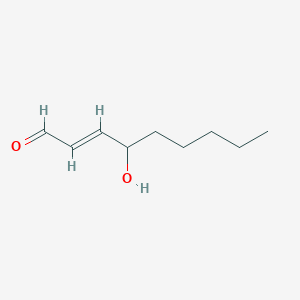| General Information of MET (ID: META00009) |
| Name |
4-Hydroxynonenal
|
| Synonyms |
Click to Show/Hide Synonyms of This Metabolite
(e)-4-Hydroxy-2-nonenal; 4-HNE CPD; 4-Hydroxy-2,3-nonenal; 4-Hydroxy-2,3-trans-nonenal; 4-Hydroxy-2-nonenal; 4-Hydroxy-2-nonenal, (e)-isomer; 4-Hydroxynon-2-enal; 4-Hydroxynonen-2-al; HNE; trans-4-Hydroxy-2-nonenal
|
| Source |
Endogenous;Fatty acyls;Food;Toxins/Pollutant
|
| Structure Type |
Fatty alcohols (Click to Show/Hide the Complete Structure Type Hierarchy)
Lipids and lipid-like molecules
Fatty Acyls
Fatty alcohols
|
| PubChem CID |
|
| HMDB ID |
|
| Formula |
C9H16O2
|
| Structure |
<iframe style="width: 300px; height: 300px;" frameborder="0" src="https://embed.molview.org/v1/?mode=balls&cid=5283344"></iframe>
|
 |
|
3D MOL
|
2D MOL
|
|
Click to Show/Hide the Molecular/Functional Data (External Links/Property/Function) of This Metabolite
|
| ChEBI ID |
|
| FooDB ID |
|
| ChemSpider ID |
|
| Physicochemical Properties |
Molecular Weight |
156.22 |
Topological Polar Surface Area |
37.3 |
| XlogP |
1.7 |
Complexity |
119 |
| Heavy Atom Count |
11 |
Rotatable Bond Count |
6 |
| Hydrogen Bond Donor Count |
1 |
Hydrogen Bond Acceptor Count |
2 |
| Function |
4-Hydroxynonenal (HNE), one of the major end products of lipid peroxidation, has been shown to be involved in signal transduction and available evidence suggests that it can affect cell cycle events in a concentration-dependent manner. glutathione S-transferases (GSTs) can modulate the intracellular concentrations of HNE by affecting its generation during lipid peroxidation by reducing hydroperoxides and also by converting it into a glutathione conjugate. Overexpression of the Alpha class GSTs in cells leads to lower steady-state levels of HNE, and these cells acquire resistance to apoptosis induced by lipid peroxidation-causing agents such as H(2)O(2), UVA, superoxide anion, and pro-oxidant xenobiotics, suggesting that signaling for apoptosis by these agents is transduced through HNE. Cells with the capacity to exclude HNE from the intracellular environment at a faster rate are relatively more resistant to apoptosis caused by H(2)O(2), UVA, superoxide anion, and pro-oxidant xenobiotics as well as by HNE, suggesting that HNE may be a common denominator in mechanisms of apoptosis caused by oxidative stress. Transfection of adherent cells with HNE-metabolizing GSTs leads to transformation of these cells due to depletion of HNE. HNE has also been identified as a uremic toxin according to the European Uremic Toxin Working Group.
|
|
Regulatory Network
|
|
|
|
|
|
|
|
|
 click to show the details of this protein
click to show the details of this protein
 click to show the details of experiment for validating this pair
click to show the details of experiment for validating this pair

